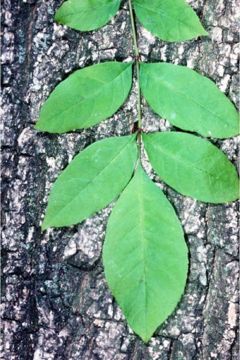Green Ash: Difference between revisions
No edit summary |
No edit summary |
||
| Line 1: | Line 1: | ||
{{Inc| | |||
Fraxinus pennsylvanica, Marsh. (F. pubescens, Lam.). Red Ash. Tree, to 60 ft.: brancnlets and petioles pubescent: lfts. 5-9, stalked, ovate to oblong-lanceolate, acuminate, crenately serrate or entire, pubescent beneath, 3-6 in. long: fr. linear-spatulate, about 2 in. long, with somewhat decurrent wing. Canada to Fla., west to Dakota and Mo. 8.8.6:271.—This species varies considerably in the amount of pubescence and the shape of the lfts., and many forms under different names are grown in European nurseries and gardens. Var. aucubaefolia, Hort., is a form with less pubescent lvs., blotched yellow. There are also variegated forms with the lvs. blotched white or edged white. | |||
}} | |||
{{Taxobox | {{Taxobox | ||
| color = lightgreen | | color = lightgreen | ||
Revision as of 06:50, 18 August 2009
| Standard Cyclopedia of Horticulture |
|---|
|
Fraxinus pennsylvanica, Marsh. (F. pubescens, Lam.). Red Ash. Tree, to 60 ft.: brancnlets and petioles pubescent: lfts. 5-9, stalked, ovate to oblong-lanceolate, acuminate, crenately serrate or entire, pubescent beneath, 3-6 in. long: fr. linear-spatulate, about 2 in. long, with somewhat decurrent wing. Canada to Fla., west to Dakota and Mo. 8.8.6:271.—This species varies considerably in the amount of pubescence and the shape of the lfts., and many forms under different names are grown in European nurseries and gardens. Var. aucubaefolia, Hort., is a form with less pubescent lvs., blotched yellow. There are also variegated forms with the lvs. blotched white or edged white.
|
| Green Ash {{{status}}} Fossil range: {{{fossil_range}}}
| ||||||||||||||||||||||||||||||||||||||||||||||||||||||||||||||||||
|---|---|---|---|---|---|---|---|---|---|---|---|---|---|---|---|---|---|---|---|---|---|---|---|---|---|---|---|---|---|---|---|---|---|---|---|---|---|---|---|---|---|---|---|---|---|---|---|---|---|---|---|---|---|---|---|---|---|---|---|---|---|---|---|---|---|---|
 Green Ash leaf and bark | ||||||||||||||||||||||||||||||||||||||||||||||||||||||||||||||||||
| Plant Info | ||||||||||||||||||||||||||||||||||||||||||||||||||||||||||||||||||
| ||||||||||||||||||||||||||||||||||||||||||||||||||||||||||||||||||
| Scientific classification | ||||||||||||||||||||||||||||||||||||||||||||||||||||||||||||||||||
| ||||||||||||||||||||||||||||||||||||||||||||||||||||||||||||||||||
| [[{{{diversity_link}}}|Diversity]] | ||||||||||||||||||||||||||||||||||||||||||||||||||||||||||||||||||
| {{{diversity}}} | ||||||||||||||||||||||||||||||||||||||||||||||||||||||||||||||||||
| Binomial name | ||||||||||||||||||||||||||||||||||||||||||||||||||||||||||||||||||
| Fraxinus pennsylvanica Marsh. | ||||||||||||||||||||||||||||||||||||||||||||||||||||||||||||||||||
| Trinomial name | ||||||||||||||||||||||||||||||||||||||||||||||||||||||||||||||||||
| {{{trinomial}}} | ||||||||||||||||||||||||||||||||||||||||||||||||||||||||||||||||||
| Type Species | ||||||||||||||||||||||||||||||||||||||||||||||||||||||||||||||||||
| {{{type_species}}} | ||||||||||||||||||||||||||||||||||||||||||||||||||||||||||||||||||
| {{{subdivision_ranks}}} | ||||||||||||||||||||||||||||||||||||||||||||||||||||||||||||||||||
| [[Image:{{{range_map}}}|{{{range_map_width}}}|]] | ||||||||||||||||||||||||||||||||||||||||||||||||||||||||||||||||||
| Synonyms | ||||||||||||||||||||||||||||||||||||||||||||||||||||||||||||||||||
| {{{synonyms}}} |
Green Ash, Red Ash, or Swamp Ash is a species of ash native to eastern and central North America, from central Saskatchewan and southern Quebec south to eastern Texas and northern Florida; also the western U.S. states of Montana, Utah, and New Mexico, eastward. It is common in the wet soils of swamps, river valleys that are submerged part of the year, and in swamp forests.
It is a medium-sized deciduous tree reaching 15-25 m (45-75 ft.) tall with a trunk up to 50 cm in diameter. The tree's autumn color is an attractive golden-yellow, and the tree is usually the earliest to change color, sometimes being in autumn color as early as Labor Day. The flowers are produced in spring at the same time as the new leaves, in compact panicles; they are inconspicuous with no petals, and are wind-pollinated. The fruit is a samara comprising a single seed 1.5-2 cm long with an elongated apical wing 2-3 cm long and 5-7 mm broad.
It is sometimes divided into two varieties (Red Ash and Green Ash) on the basis of the narrower leaflets of the latter, but the two intergrade completely, and the distinction is no longer upheld by most botanists.
It is seriously threatened in some areas, particularly Michigan, by the emerald ash borer, a beetle introduced accidentally from Asia.
Uses
Green Ash is one of the most widely planted ornamental trees throughout the United States and much of Canada, including in western areas where it is not native. 40% of boulevard trees in Edmonton, Alberta are Green Ash.[1] It has several drawbacks as an urban tree, notably a relatively short lifespan compared to many trees (rarely over 100 years, often only 30-50 years), and (recently) the threat from the emerald ash borer. Advantages include its tolerance of urban conditions, ease of propagation, and (in eastern North America) its value for wildlife as a native species.